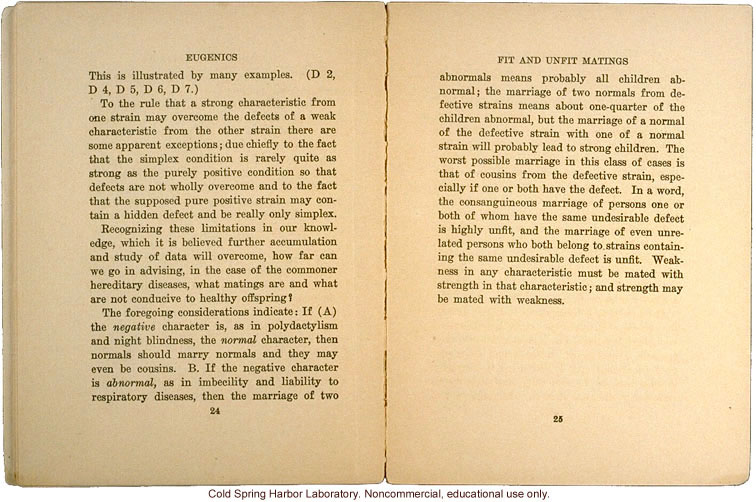[left side]
Eugenics
This is illustrated by many examples. (D 2, D 4, D 5, D 6, D 7.)
To the rule that a strong characteristic from one strain may overcome the defects of a weak characteristic from the other strain there are some apparent exceptions; due chiefly to the fact that the simplex condition is rarely quite as strong as the purely positive condition so that defects are not wholly overcome and to the fact that the supposed pure positive strain may contain a hidden defect and be really only simplex.
Recognizing these limitations in our knowledge, which it is believed further accumulation and study of data will overcome, how far can we go in advising, in the case of the commoner hereditary diseases, what matings are and what are not conducive to healthy offspring?
The foregoing considerations indicate: If (A) the [italics]negative[end italics] character is, as in polydactylism and night blindness, the [italics]normal[end italics] character, then normals should marry normals and they may even by cousins. B. If the negative character is [italics]abnormal[end italics], as in imbecility and liability to respiratory disease, then the marriage of two
24
[right side]
Fit and Unfit Matings
abnormals means probably all children abnormal; the marriage of two normals from defective strains means about one-quarter of the children abnormal, but the marriage of a normal from a defective strain with one of a normal strain will probably lead to strong children. The worst possible marriage in this class of cases is that of cousins from the defective strain, especially if one or both have the defect. In a word, the consanguineous marriage of persons one or both of whom have the same undesirable defect is highly unfit, and the marriage of even unrelated persons who both belong to strains containing the same undesirable defect is unfit. Weakness in any characteristic must be mated with strength in that characteristic; and strength may be mated with weakness.
25
[end]


